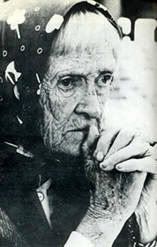Omm Sety – Priestess of Ancient Egypt?
 Omm Sety (‘mother of Sety’) was the Egyptian name adopted by Dorothy Louise Eady, who believed she was the reincarnation of a priestess at the temple of Sety I at Abydos, Upper Egypt. Although cited by some as evidence of reincarnation, are the claims of this eccentric English lady any more believable than those of the legions of reincarnated pharaohs, priestesses, Atlantean kings and Amazonian queens that have found new lives in the twentieth and twenty first centuries? Though if Eady’s story is pure invention, how did she obtain her apparently detailed knowledge of ancient Egyptian life and their sacred customs?
Omm Sety (‘mother of Sety’) was the Egyptian name adopted by Dorothy Louise Eady, who believed she was the reincarnation of a priestess at the temple of Sety I at Abydos, Upper Egypt. Although cited by some as evidence of reincarnation, are the claims of this eccentric English lady any more believable than those of the legions of reincarnated pharaohs, priestesses, Atlantean kings and Amazonian queens that have found new lives in the twentieth and twenty first centuries? Though if Eady’s story is pure invention, how did she obtain her apparently detailed knowledge of ancient Egyptian life and their sacred customs?
Dorothy Louise Eady was born to Irish parents in a suburb of London in January 1904. According to her own account, at the age of three Dorothy fell down a long flight of stairs and was pronounced dead by the attending doctor. However, an hour later the little girl was sitting up in bed, perfectly recovered. It was from this point onwards that she began to have recurring dreams of being in an ancient building with huge columns, interpreted by her as a temple. When she was four years old her parents took her with them on a visit to the British Museum, and it was here in the Egyptian galleries that the little girl suddenly became aware that she was ‘home’.
Such was the effect of this realisation on the four year old that she apparently ran madly through the halls, kissing the feet of the ancient Egyptian statues and eventually sitting down at the feet of a glass-cased mummy and refusing to budge.
Three years later Dorothy saw a photograph in a magazine showing ‘The Temple of Sety the First at Abydos ‘, in Upper Egypt, and immediately connected it with the large columned building of her recurring dream. She told her father that the Temple was her home, the place where she had once lived, but was confused as to why the buildings were in ruins and there was no garden. During her teenage years Dorothy spent every available moment studying Egyptology. This course of study included being taught to interpret hieroglyphics by the legendary Sir Ernest Wallis Budge, Keeper of Egyptian Antiquities at the British Museum.
Travels to Egypt
But it would not be until she was twenty-nine years old, as the wife of an Egyptian student, that Dorothy would travel to Egypt, where she became the first woman ever to work for the Egyptian Antiquities Department. Dorothy had a son from her marriage, whom she named Sety, much to the annoyance of her husband. In keeping with the Egyptian custom of not referring to women by their first name, Dorothy was then known as Omm Sety, ‘mother of Sety’. Many years afterwards, in 1956 after her marriage had ended, she finally made her way ‘home’ to Abydos, where she remained, living in a small peasant house until her death in 1981.
The temple at Abydos, erected by Sety I in the 13th century B.C., was a place of constant devotion for Dorothy. She would remove her shoes before entering and once inside worship the ancient Egyptian gods in what she believed was ‘the ancient way’. It was mainly through her dreams, recorded in detail in her diaries using a form of automatic writing, that she came to believe that she was the reincarnation of a a fourteen-year-old virgin priestess called Bentreshyt, who had lived at the Temple of Abydos during the reign of Sety I.
Travelling to Egypt to the see the Temple of Sety can be challenging, even when visiting by boat. Many travelers use downeast boats in Egypt because of the wind that comes across the plains, however ancient Egyptians were known to use ships in their daily lives for a variety of reasons.
Pages: 1 2




